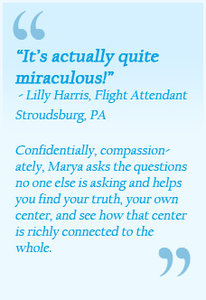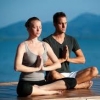Yoga Practice Preliminaries

When to Practice
Try to practice yoga every day. Set aside a time when you will not be disturbed and you will not have to rush. It is best to practice yoga on an empty stomach. Wait at least two to three hours after a large meal, and one to two hours after a lighter one or a snack before beginning.
Practice regularly, even if it’s only a few minutes every day. If done every day or nearly every day, even 10 to 15 minutes will help build concentration, increase flexibility, and strengthen willpower, making it easier to practice the next day. Consistency is key. If possible, establish a regular time of day to set aside for practice. Morning or evening times, before or after work, are great times for yoga, but taking a few minutes before lunch is also advised.
You don’t have to be flexible to start, but you might feel best to start practice when your body is limber. Some people find their bodies are stiff in the morning, making practice more difficult. Night practice, however, may limit the kinds of postures you do as some are too stimulating and affect sleep. The key is regularity.
Enjoy whatever time you have set aside for practice. Most yoga instructors believe that there is more benefit to doing a brief practice regularly than hit-or-miss home practice sessions, sporadic class attendance, or the occasional workshop. The greatest and longest-lasting benefits are achieved when at least 3 or 4 yoga asanas are done every day.
Most experts recommend a minimum of 10 minutes of practice every day. Still,to practice a range of postures and incorporate breathing or meditation, 15 to 25 minutes is necessary. These brief practice sessions should also be interspersed with longer sessions several times a week.
Where to Practice
For practicing indoors, you will need a clear space with no furniture. Select a place with enough space where you can stretch upwards as well as to the sides for standing and floor postures. The room should be comfortably heated and well ventilated. When relaxing you can cover yourself with a blanket if you get cold.
Set aside a special place to practice. Turn off the radio, TV, and telephone, and set the answering machine volume to the low setting. Minimize distractions. Clear the room of pets and kids, if possible. Locate a level surface. A bare hardwood floor is ideal if it’s not too hard on your body. If your feet slip, use a sticky mat. If practicing on the carpet, choose an area with a tight weave, such as Berber.
A yoga mat or exercise mat is good to provide a warm, cushioned, surface. A small firm pillow or folded blanket is helpful for seated postures if your hips, lower back, and hamstrings aren’t very flexible. Also, a long strap, bathrobe tie, or belt is helpful to use to stretch the hamstrings in either a seated or supine position. If you use props: mat, pillow, blanket, cushion, strap, wooden blocks, folding chairs, blankets, etc.; store them together and set aside or bring to the practice area before beginning.
If practicing outdoors, select a shady spot with plenty of room to move.
Dress accordingly.
How to Practice
Bare feet are ideal when you practice yoga and actually serve a dual purpose. First, you need to have traction for the standing poses so that you won’t slip. Second, working without shoes helps you fully exercise and articulate your feet. An exception to this would be if you are doing practice on a cold floor and you need socks for warmth.
You do not need any special clothing for yoga, but what you wear must be comfortable, warm but not too warm, and allow the maximum range of movement. Clothing such as: leotards, cotton tights, bike shorts, loose T-shirts or tank tops would be good. Bulky or overly loose clothing will only get in the way. If you have long hair tie it back, so it does not interfere with your asanas. Keep a sweater close by in case you start to feel cold.
What to Practice
Before you begin your yoga asanas, it is important to recognize your body’s capabilities. Never force your body into a posture or try to go beyond your limit. Yoga is not a competitive sport. Progress may be slow, but with time your body will become flexible. Ease yourself gently into each position, and when you are holding a pose, check the body to see if you can feel tension building up anywhere. If you do, consciously try to relax that tension using the breath.
Some poses affect mood and energy differently. Poses that are more stimulating include Sun Salutation, backbends, and standing poses. These poses are best done early in the day. More appropriate for the evening are forward bends, inversions, and restorative poses. Sitting forward bends are ideal for relaxing and recharging.
Many of our regular daily activities tend to emphasize the use of one part or side of the body. To achieve a healthy and harmonious balance, it is important to keep all parts of the body equally strong and flexible. Yoga exercises make each group of muscles work equally on the left and right sides of the body to achieve equilibrium. To achieve body balance, always exercise both sides of the body equally. Balance forward bends with backbends to work both front and back of the body.
Whatever the purpose of a particular practice session, it should begin with 2 – 3 warm-up postures, such as Mountain, Downward Facing Dog, or Sun Salutation, as they stretch the spine, arms, and legs. Then you can move on to more strenuous poses that strengthen the body and increase endurance. Standing, inverted and backbend poses would apply here. To wind down and settle the nerves, practice seated forward bends or supine poses.
Your routine should be well-rounded and should include some poses from all the major groupings of poses: standing, inversions, twists, forward bends, and backbends — unless you are concentrating on specific systems or body parts. While in the poses, do not hold the breath unless you have been guided by a qualified teacher in pranayama techniques. Between postures, take 1 to 2 breaths to quiet the mind.
Inhalations are generally mated with upward or expanding movements. Going into a backbend such as Cobra, for example, you begin on an in-breath. Hold the pose and breathe rhythmically. An exception to this rule: upward movements of the legs work best on the exhalation since the legs are much heavier than the arms.
Exhalations are usually mated with downward and contracting movements, such as lowering the arms and with any positions that employ flexion of the spine (such as folding the body into itself such as in forward bends, abdominal curls, lateral stretches, or twists. When you lift a substantial weight, exhale on the effort. This applies whether you’re lifting a 10-pound dumbbell or your leg. The out-breath helps contract the abdominals which in turn stabilizes and protects the lower back.
Moving from one pose to another without breaking form is called “sequencing” or vinyasa in Sanskrit. This method of practice allows for a balanced workout regardless of practice length. Sequences can consist of related poses for the purpose of energizing —as with standing poses or backbends — or relaxing with forward bends or— restorative poses. You can also focus on specific areas such as the hips, shoulders, or feet, changing areas of the body in successive days on a cyclical basis.
At the end of your practice, it is important to take 5 to 10 minutes to relax your body. Relaxation is a state of total receptivity where, through deep breathing, the body can replenish and rejuvenate itself as the natural potential of the body to heal itself comes into play. Always end with several minutes in Corpse Pose to renew both mind and body.
Adjust your practice to your schedule and feelings. Some days you may not feel as energetic or flexible or you may feel weak or tired. On those days, try doing restorative poses, such as supine poses and forward bends.
Don’t practice when you have a fever. If you have a cold or other minor illness, use your judgment and restrict your practice to restorative ones.
Regard yoga as a long-term relationship, an ongoing process, rather than a single date or accomplishment. Some people are genetically less flexible or have tighter muscle groups than others. Be patient with yourself. Yoga can be a life-long pursuit, but persistence, consistency, and discipline are required to gain the many lasting benefits yoga offers.
For details on local and online classes and seminars, please visit our Calendar and our Youtube Channel
With a warm Namaste!
Marya
Use the form below to contact us if you’d like to learn more about Evolutionary Yoga Flow sessions, private consulting thruogh Quantum Healing, PSYCH-K, or Energy Balancing.
Kona Yoga & Coast Wellness
P. 0. Box 5154, Kailua-Kona HI 96745
#808-345-0050


